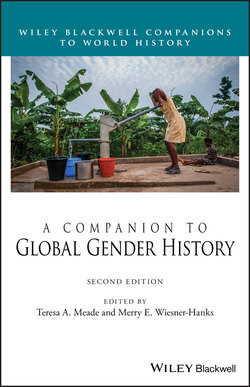Читать книгу A Companion to Global Gender History - Группа авторов - Страница 19
Militarization, Decentralization, and Gender Divisions in Feudal Societies
ОглавлениеThe progressive militarization of societies accentuated the gender division of labor in which men’s skills as warriors became increasingly valuable for defending territorial integrity or for maintaining trade routes. Over several centuries, ideas about the desirability of a public role for men and a private role for women came to influence the discourses and cultural practices shaping gender and labor in everyday life. In Western Europe and Asia, the progressive devaluation of women’s work accompanied the gradual emergence of centralized, bureaucratic states.
In the political decentralization that prevailed in Western Europe between the fall of the Roman Empire (about 476 CE) and the emergence of states in the thirteenth century, the political system known as feudalism revolved around ties of personal loyalty to leaders who sustained their leadership with private armies. Such a system had for a long time been the rule in China and Japan. Lower‐class men and women tilled the soil and plied their trades on estates, dependent on elite male warriors who were supposed to protect them from invaders. In Western Europe, many Christian writers and thinkers, like their counterparts several centuries later, promulgated ideas about women’s weakness and vulnerability that promoted gender difference and division that lasted for centuries (Bitel, 1998: 108). But as influential as they were, they did not completely circumscribe women’s economic activities.
There is historical evidence that in this period women controlled their personal property and that widows could conduct business. Women and men on the rural estates of feudal Europe farmed and performed hard manual labor alongside one another. Women took responsibility for domestic tasks – including meal preparation, baking bread, and brewing beer – as well as textile production and garment‐making for household use. In some cases, Muslim, North African, or Eastern European women slaves worked as servants in the households of rich nobles or as agricultural laborers on the estates of medieval Europe (Stuard, 1995). In spite of Christian doctrines emphasizing women’s inferiority, and legal customs that limited women’s formal rights, women participated in the public urban life of the eleventh and twelfth centuries as traders, selling beer, crafts, clothing, or agricultural goods at local markets. In the decentralized European societies of this period plagued by conflict and war, women often assumed responsibility for administering estates, if not entire territories, in the absence of men. A similar flexible division of labor also existed in feudal Japan, where men served in the military, and women prevailed in the household and held important positions in religious institutions. This situation lasted until Japanese rulers centralized state authority and diminished the power of local feudal lords.
Even in socially stratified, complex societies, women worked at the same tasks as men and enjoyed a relatively high status based on their productive activities. Ethnohistorical evidence suggests considerable fluidity in the relationship of gender and technical expertise among the Maya of Central America for example, where women were primarily responsible for skilled production of pottery, produced with clay dug by men. And research on the pre‐Hispanic Americas has also shown that women were responsible for the massive cloth production central to the Andean economy (Arden, 2008). These patterns of gender complementarity continued with the development of more centralized states, urbanization, and the emergence of new economic institutions and relations.
